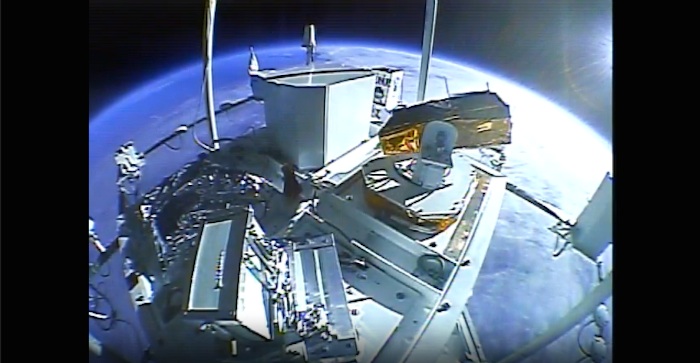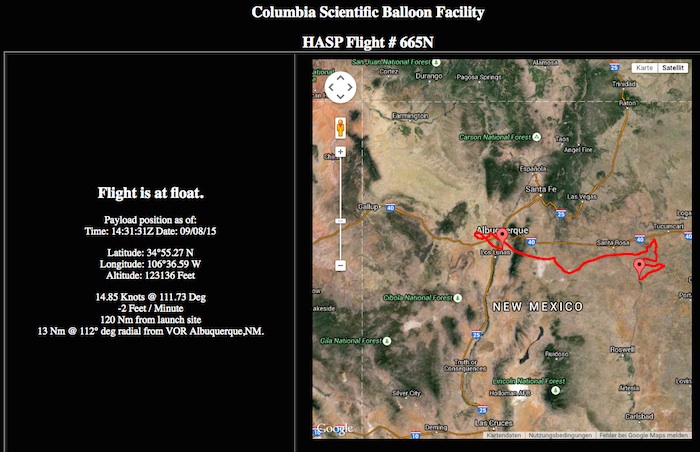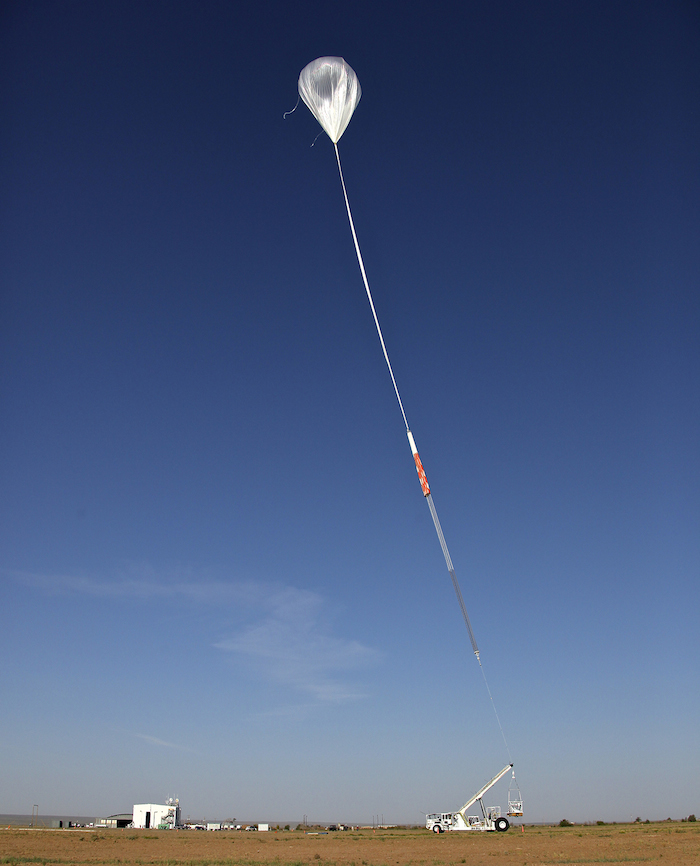.

NASA kicks off scientific ballooning campaign in New Mexico
Mars-bound microbes, student experiments, and cosmic ray measuring equipment and are just some of the items getting a lift to near-space courtesy NASA’s scientific ballooning program.
Four NASA scientific balloon flights will carry multiple payloads containing science instruments and experiments to altitudes upward of 120,000 feet above 99.5 percent of the Earth’s atmosphere during NASA’s upcoming balloon campaign in Fort Sumner, New Mexico, which is scheduled to begin August 31.
“NASA’s scientific balloons offer access to altitudes key to scientific research in heliophysics, astrophysics, planetary and earth sciences,” said Debbie Fairbrother, NASA’s Balloon Program Office chief. “The depth and breadth of missions flying during this campaign really show the versatility of balloon-based research platforms.”
A highlight of the campaign is NASA Langley Research Center’s Radiation Dosimetry Experiment (RaD-X), scheduled to launch Sept. 11. RaD-X will measure cosmic ray energy at two separate altitude regions in the stratosphere—above 110,000 feet and between 69,000 to 88,500 feet. The data is key to confirming Langley’s Nowcast of Atmospheric Ionizing Radiation for Aviation Safety (NAIRAS) model, which is a physics-based model that determines solar radiation and galactic cosmic ray exposure globally in real-time. The NAIRAS modeling tool will be used to help enhance aircraft safety as well as safety procedures for the International Space Station.
In addition to the primary payload, 100 small student experiments will fly on the RaD-X mission as part of the Cubes in Space program. The program provides 11- to 18-year-old middle and high school students a no-cost opportunity to design and compete to launch an experiment into space or into the near-space environment. The cubes measure just 4 centimeters by 4 centimeters.
Other missions in the 2015 Fort Sumner Balloon Campaign are:
Balloon technology test flight #1—Aug. 31. This mission will test a number of balloon system technology developments as well as support a multitude of missions of opportunity. When a balloon mission is complete, flight controllers issue a flight termination command that separates the payload from the balloon while simultaneously ripping a hole in the balloon for rapid deflation. A parachute then deploys bringing the payload back to the ground, where it is recovered. When the payload lands, the parachute automatically cuts away, but can remain inflated resulting in the parachute and attached electronic systems drifting along the ground. To prevent this effect, the first balloon flight of the campaign will test a new parachute device designed to immediately deflate the parachute after the payload lands.
In addition, a number of missions of opportunity are flying aboard this mission. NASA’s Glenn Research Center will perform a test of their Autonomously Navigated paragliding Experimental Lander (ANGEL), which will demonstrate a controllable descent for balloon payloads, in turn enabling faster, easier and cheaper recovery.
Also, Marshall Space Flight Center will fly their Advanced Neuron Spectrometer (ANS) and the University of Arizona will fly their Large Balloon Reflector Sensor Package (LBRSP).
High-Altitude Student Platform (HASP)—Sept. 7. In partnership with the Louisiana Space Consortium, the Balloon Program will launch the annual HASP payload, which carries up to 12 student experiments built by college students from across the nation. This is the 10th HASP mission since the program’s inception in 2005. Since then, more than 830 students from 34 academic institutions from across 19 states and Puerto Rico have developed HASP experiments for flight on a NASA balloon.
Participating institutions for the 2015 HASP flight are: Embry-Riddle Aeronautical University, Arizona; University of Minnesota; University of Calgary, Canada; Illinois Institute of Technology; University of Colorado; University of North Dakota; University of North Florida; Gannon University, Pennsylvania; University of North Carolina-Chapel Hill; and Louisiana State University.
Balloon technology test flight #2—Sept. 17. The final flight of the Fort Sumner campaign includes additional technology developments and missions of opportunity. Another parachute deflation test will be conducted as well as tests for an azimuth rotator and enhanced telemetry systems.
In addition, there are five missions of opportunity flying on the test flight. For a second year, Ames Research Center and Kennedy Space Center will fly their Exposing Microorganisms in the Stratosphere (E-MIST) payload. E-MIST is designed to understand how spore-forming bacteria commonly found at spacecraft assembly facilities, and in turn on the spacecraft itself, may survive in space or on other planetary bodies, namely Mars. E-MIST will operate at an altitude with characteristics analogous to the Martian atmosphere. The goal of the experiment is to develop procedures for preventing microbial contamination of Mars by robotic spacecraft exploration.
Also, Goddard Space Flight Center is flying the Micro-Return Capsule (MIRCA) as part of a Cubesat Application for Planetary Entry (CAPE) mission. Other payloads include the University of Virginia’s Jeffersat Cosmic Ray Mission (JSATCRM) and Utah State University’s Red Line Air Glow Sensor (RLAGS), each a part of NASA’s Undergraduate Student Instrument Project. In addition, the University of Alabama will fly its Extreme Universe Space Observatory Infrared camera (EUSO IR).
NASA’s scientific balloons offer low-cost, near-space access for scientific payloads weighing up to 8,000 pounds for conducting scientific investigations in fields such as astrophysics, heliophysics and atmospheric research.
Standard NASA balloons are very large structures, some as large as football stadiums when fully inflated, comprised of 10 to 50 acres or more of film that can carry payloads to altitudes above 130,000 feet. Balloon film resembles sandwich bags, but is stronger and more durable.
NASA’s Wallops Flight Facility in Virginia manages the agency’s scientific balloon program with 10 to 15 flights each year from launch sites worldwide.
.

.

Student Experiments Get a Lift From NASA’s Scientific Balloon Program
NASA’s Balloon Program Office in partnership with the Louisiana Space Grant Consortium launched the High-Altitude Student Platform (HASP) payload at 7:47 a.m. MDT Monday, Sept. 7, from Fort Sumner, N.M.
HASP, which is carrying 12 student experiments built by college students from across the nation, is expected to fly to an operational altitude of 120,000 feet during its mission, which will last 10 to 20 hours.
“It’s incredibly rewarding to support the students flying these experiments, many of whom are getting their first real taste of hands-on engineering and science,” said Debbie Fairbrother, NASA’s Balloon Program Office chief. “Programs like HASP are key to educating, training, and inspiring the next generation.”
This launch is the 10th HASP mission since the program’s inception in 2005. Since then, more than 830 students from 34 academic institutions from across 19 states and Puerto Rico have developed HASP experiments for flight on a NASA balloon.
Participating institutions for the 2015 HASP flight are: Embry-Riddle Aeronautical University, Arizona; University of Minnesota; University of Calgary, Canada; Illinois Institute of Technology; University of Colorado; University of North Dakota; University of North Florida; Gannon University, Pennsylvania; University of North Carolina-Chapel Hill; and Louisiana State University.
Today’s launch is the second of four NASA has planned during the Fort Sumner campaign. The agency’s next balloon launch is scheduled Friday, Sept. 11, carrying Langley Research Center’s Radiation Dosimetry Experiment (RaD-X) along with 100 small student experiments flying as part of the Cubes in Space program. In addition, a balloon test flight is planned for Sept. 17 and will carry five mission of opportunity payloads.
NASA’s scientific balloons offer low-cost, near-space access for scientific payloads weighing up to 8,000 pounds for conducting scientific investigations in fields such as astrophysics, heliophysics and atmospheric research.
Standard NASA balloons are very large structures, some as large as football stadiums when fully inflated, comprised of 10 to 50 acres or more of film that can carry payloads to altitudes above 130,000 feet. Balloon film resembles sandwich bags, but is stronger and more durable.
NASA’s Wallops Flight Facility in Virginia manages the agency’s scientific balloon program with 10 to 15 flights each year from launch sites worldwide.
The Louisiana Space Grant Consortium is part of the National Space Grant College and Fellowship Program, which supports hands-on, experiential projects for university-level students nationwide.
Orbital ATK provides program management, mission planning, engineering services and field operations for NASA’s scientific balloon program. The program is executed from the Columbia Scientific Balloon Facility in Palestine, Texas. The Columbia team has launched more than 1,700 scientific balloons in over 35 years of operation.
Quelle: NASA
4757 Views
